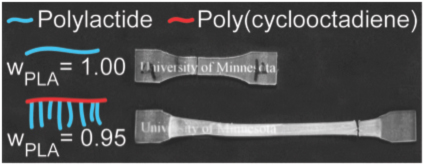

Main navigation | Main content
02/04/2011
Recent research from the research group of Professor Marc Hillmyer
Plastics are indispensable and are used in everything from medical devices to children's toys. However, the majority of plastics are derived from fossil fuels. The finite global supply of those non-renewable resources will eventually necessitate the shift to renewable alternatives. Derived from corn, polylactide (PLA) is a renewable resource and biodegradable polyester produced on a commercial scale that can be found in applications such as disposable packaging. Unfortunately, the inherently brittle behavior of PLA has prevented it from more widespread application.
Grayce Theryo, a graduate research assistant in the Hillmyer research group, has focused on utilizing rubber toughening to create more mechanically robust polylactide-based materials. She recently reported in a communication to Macromolecules 2010, 43, 7394, that creating a polylactide-based graft copolymer results in an increase in tensile ductility. The block copolymer consisted of polylactide arms emanating from a rubbery backbone. The backbone was synthesized first via ring-opening metathesis polymerization to yield a macroinitiator possessing pendant hydroxyl groups. Then, ring-opening transesterification polymerization of lactide was initiated from these hydroxyl groups. Microphase separation of polylactide and rubber in a graft copolymer containing only 5 wt% rubber was confirmed by small-angle x-ray scattering and transmission electron microscopy. The small rubber domain size renders these new composites optically clear which can be beneficial for packaging applications. Tensile testing of the graft copolymer revealed a 14-fold increase in the toughness as compared with the parent homopolymer polylactide.
This tough polylactide-based material will open doors to other advanced renewable polymers with mechanical properties that can facilitate more extensive implementation of these next generation plastics.
